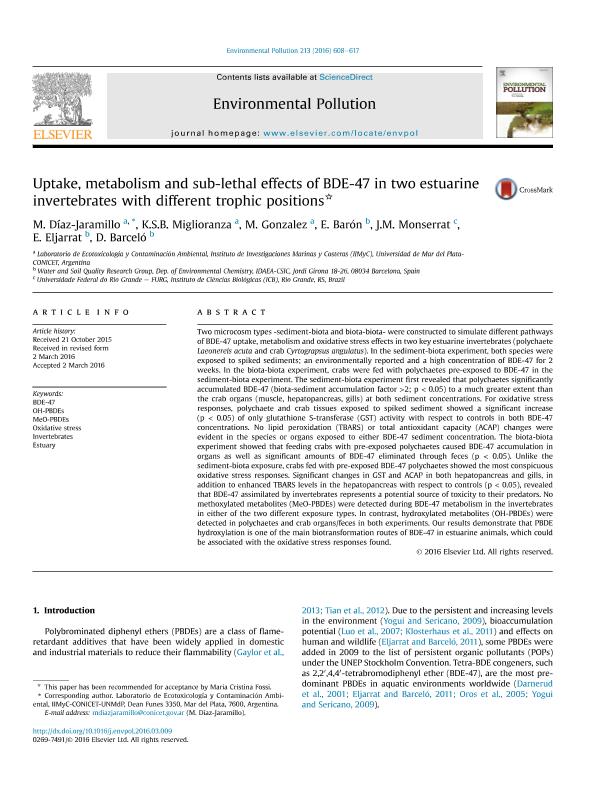Mostrar el registro sencillo del ítem
dc.contributor.author
Diaz Jaramillo, Mauricio Javier

dc.contributor.author
Miglioranza, Karina Silvia Beatriz

dc.contributor.author
Gonzalez, Mariana

dc.contributor.author
Barón, E.
dc.contributor.author
Monserrat, José María

dc.contributor.author
Eljarrat, E.
dc.contributor.author
Barceló, D.
dc.date.available
2018-10-12T18:50:39Z
dc.date.issued
2016-06
dc.identifier.citation
Diaz Jaramillo, Mauricio Javier; Miglioranza, Karina Silvia Beatriz; Gonzalez, Mariana; Barón, E.; Monserrat, José María; et al.; Uptake, metabolism and sub-lethal effects of BDE-47 in two estuarine invertebrates with different trophic positions; Elsevier; Environmental Pollution; 213; 6-2016; 608-617
dc.identifier.issn
0269-7491
dc.identifier.uri
http://hdl.handle.net/11336/62362
dc.description.abstract
Two microcosm types -sediment-biota and biota-biota- were constructed to simulate different pathways of BDE-47 uptake, metabolism and oxidative stress effects in two key estuarine invertebrates (polychaete Laeonereis acuta and crab Cyrtograpsus angulatus). In the sediment-biota experiment, both species were exposed to spiked sediments; an environmentally reported and a high concentration of BDE-47 for 2 weeks. In the biota-biota experiment, crabs were fed with polychaetes pre-exposed to BDE-47 in the sediment-biota experiment. The sediment-biota experiment first revealed that polychaetes significantly accumulated BDE-47 (biota-sediment accumulation factor >2; p < 0.05) to a much greater extent than the crab organs (muscle, hepatopancreas, gills) at both sediment concentrations. For oxidative stress responses, polychaete and crab tissues exposed to spiked sediment showed a significant increase (p < 0.05) of only glutathione S-transferase (GST) activity with respect to controls in both BDE-47 concentrations. No lipid peroxidation (TBARS) or total antioxidant capacity (ACAP) changes were evident in the species or organs exposed to either BDE-47 sediment concentration. The biota-biota experiment showed that feeding crabs with pre-exposed polychaetes caused BDE-47 accumulation in organs as well as significant amounts of BDE-47 eliminated through feces (p < 0.05). Unlike the sediment-biota exposure, crabs fed with pre-exposed BDE-47 polychaetes showed the most conspicuous oxidative stress responses. Significant changes in GST and ACAP in both hepatopancreas and gills, in addition to enhanced TBARS levels in the hepatopancreas with respect to controls (p < 0.05), revealed that BDE-47 assimilated by invertebrates represents a potential source of toxicity to their predators. No methoxylated metabolites (MeO-PBDEs) were detected during BDE-47 metabolism in the invertebrates in either of the two different exposure types. In contrast, hydroxylated metabolites (OH-PBDEs) were detected in polychaetes and crab organs/feces in both experiments. Our results demonstrate that PBDE hydroxylation is one of the main biotransformation routes of BDE-47 in estuarine animals, which could be associated with the oxidative stress responses found.
dc.format
application/pdf
dc.language.iso
eng
dc.publisher
Elsevier

dc.rights
info:eu-repo/semantics/openAccess
dc.rights.uri
https://creativecommons.org/licenses/by-nc-nd/2.5/ar/
dc.subject
Bde-47
dc.subject
Estuary
dc.subject
Invertebrates
dc.subject
Meo-Pbdes
dc.subject
Oh-Pbdes
dc.subject
Oxidative Stress
dc.subject.classification
Ciencias Medioambientales

dc.subject.classification
Ciencias de la Tierra y relacionadas con el Medio Ambiente

dc.subject.classification
CIENCIAS NATURALES Y EXACTAS

dc.title
Uptake, metabolism and sub-lethal effects of BDE-47 in two estuarine invertebrates with different trophic positions
dc.type
info:eu-repo/semantics/article
dc.type
info:ar-repo/semantics/artículo
dc.type
info:eu-repo/semantics/publishedVersion
dc.date.updated
2018-10-12T18:08:19Z
dc.journal.volume
213
dc.journal.pagination
608-617
dc.journal.pais
Países Bajos

dc.journal.ciudad
Amsterdam
dc.description.fil
Fil: Diaz Jaramillo, Mauricio Javier. Consejo Nacional de Investigaciones Científicas y Técnicas. Centro Científico Tecnológico Conicet - Mar del Plata. Instituto de Investigaciones Marinas y Costeras. Universidad Nacional de Mar del Plata. Facultad de Ciencia Exactas y Naturales. Instituto de Investigaciones Marinas y Costeras; Argentina
dc.description.fil
Fil: Miglioranza, Karina Silvia Beatriz. Consejo Nacional de Investigaciones Científicas y Técnicas. Centro Científico Tecnológico Conicet - Mar del Plata. Instituto de Investigaciones Marinas y Costeras. Universidad Nacional de Mar del Plata. Facultad de Ciencia Exactas y Naturales. Instituto de Investigaciones Marinas y Costeras; Argentina
dc.description.fil
Fil: Gonzalez, Mariana. Consejo Nacional de Investigaciones Científicas y Técnicas. Centro Científico Tecnológico Conicet - Mar del Plata. Instituto de Investigaciones Marinas y Costeras. Universidad Nacional de Mar del Plata. Facultad de Ciencia Exactas y Naturales. Instituto de Investigaciones Marinas y Costeras; Argentina
dc.description.fil
Fil: Barón, E.. Instituto de Diagnóstico Ambiental y Estudios del Agua; España. Consejo Superior de Investigaciones Científicas; España
dc.description.fil
Fil: Monserrat, José María. Universidade Federal do Rio Grande; Brasil
dc.description.fil
Fil: Eljarrat, E.. Instituto de Diagnóstico Ambiental y Estudios del Agua; España. Consejo Superior de Investigaciones Científicas; España
dc.description.fil
Fil: Barceló, D.. Instituto de Diagnóstico Ambiental y Estudios del Agua; España. Consejo Superior de Investigaciones Científicas; España
dc.journal.title
Environmental Pollution

dc.relation.alternativeid
info:eu-repo/semantics/altIdentifier/url/http://www.sciencedirect.com/science/article/pii/S0269749116301907
dc.relation.alternativeid
info:eu-repo/semantics/altIdentifier/doi/http://dx.doi.org/10.1016/j.envpol.2016.03.009
Archivos asociados
